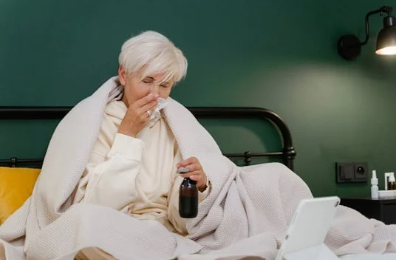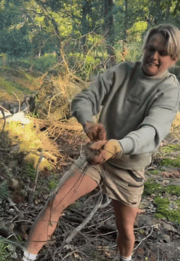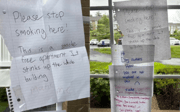Plummeting vaccine rates spark warnings across the country. Are you at risk?
By
Danielle F.
- Replies 14
As the winter chill sets in across the country, Aussies are wrapping themselves up to stay warm and toasty.
However, health experts have raised the alarm about a worrying trend and its possibly dire consequences, especially for seniors and young children.
Despite the fact that flu shots are free for many Australians, health experts have seen a low number of flu vaccination rates nationwide.
According to statistics, fewer than one in three children under five have received their flu jabs this year.
Meanwhile, 32.5 per cent of seniors aged 65 and above have been vaccinated against the flu.

According to Professor Julie Leask of the University of Sydney's Infectious Diseases Institute, Australia's flu vaccination coverage has been 'perpetually low'.
Professor Leask also added that a chunk of flu-related hospitalisations were 'potentially preventable'.
'The vaccine isn't perfect, but it's much better than zero, which is what you're looking at if you don't have a vaccine,' Professor Leask added.
'Of course, there are other measures to reduce the risk of respiratory infections, but nothing matches an effectiveness of even between 50 and 70 per cent and even better in children having that vaccine.'
The 2025 National Vaccination Insights Project shared that cost, inconvenience, and lack of access in rural and regional areas have become significant barriers to vaccination.
Some people cannot get to a GP or pharmacy easily.
Meanwhile, others have been put off by the price tag if they don't qualify for a free shot.
Yet, Professor Leask shared another factor at play: vaccine fatigue.
'The idea here is that after COVID, people were really over the topic of vaccination,' Professor Leask said.
'There might have been a bit of a backlash in some groups about that, and people wanted to get on with their lives and were a little bit disengaged from vaccination.'
While it's easy to dismiss the flu as a minor inconvenience, the reality could be much more serious.
According to the Australian Bureau of Statistics (ABS), 84 Australians have died from influenza within the first quarter of 2025.
Dr Paul Griffin, an infectious diseases physician, warned that the flu causes thousands of deaths and around 20,000 hospitalisations every year in Australia.
'Hundreds of thousands of doctor visits and quite a lot of financial implications in terms of lost work days,' Dr Griffin said.
'So while a lot of people underestimate the flu at the moment, the impact is very significant.'

Most people get their flu shot at their GP, local pharmacy, or at work.
For seniors over 65, the vaccine is free and specially formulated for older immune systems.
Many pharmacies offer walk-in appointments, making it easier than ever to get protected.
For seniors living in rural and regional areas, you may check with your local health service or council for mobile clinics or special vaccination days.
Experts also stated that better communication, more convenience, and ongoing myth-busting are key steps to improving vaccination rates in the country.
'We might not think we're at risk, but we may help protect other people who are,' Professor Leask said.
With flu season in full swing, it's time to talk to your GP or pharmacist about getting vaccinated.

Have you had your flu shot this year? What are your thoughts about this looming flu season? Share your thoughts and experiences with flu vaccines in the comments section below!
However, health experts have raised the alarm about a worrying trend and its possibly dire consequences, especially for seniors and young children.
Despite the fact that flu shots are free for many Australians, health experts have seen a low number of flu vaccination rates nationwide.
According to statistics, fewer than one in three children under five have received their flu jabs this year.
Meanwhile, 32.5 per cent of seniors aged 65 and above have been vaccinated against the flu.

Flu-related hospital visits have sparked concerns among health authorities. Image Credit: Pexels/Tima Miroshnichenko
According to Professor Julie Leask of the University of Sydney's Infectious Diseases Institute, Australia's flu vaccination coverage has been 'perpetually low'.
Professor Leask also added that a chunk of flu-related hospitalisations were 'potentially preventable'.
'The vaccine isn't perfect, but it's much better than zero, which is what you're looking at if you don't have a vaccine,' Professor Leask added.
'Of course, there are other measures to reduce the risk of respiratory infections, but nothing matches an effectiveness of even between 50 and 70 per cent and even better in children having that vaccine.'
The 2025 National Vaccination Insights Project shared that cost, inconvenience, and lack of access in rural and regional areas have become significant barriers to vaccination.
Some people cannot get to a GP or pharmacy easily.
Meanwhile, others have been put off by the price tag if they don't qualify for a free shot.
Yet, Professor Leask shared another factor at play: vaccine fatigue.
'The idea here is that after COVID, people were really over the topic of vaccination,' Professor Leask said.
'There might have been a bit of a backlash in some groups about that, and people wanted to get on with their lives and were a little bit disengaged from vaccination.'
While it's easy to dismiss the flu as a minor inconvenience, the reality could be much more serious.
According to the Australian Bureau of Statistics (ABS), 84 Australians have died from influenza within the first quarter of 2025.
Dr Paul Griffin, an infectious diseases physician, warned that the flu causes thousands of deaths and around 20,000 hospitalisations every year in Australia.
'Hundreds of thousands of doctor visits and quite a lot of financial implications in terms of lost work days,' Dr Griffin said.
'So while a lot of people underestimate the flu at the moment, the impact is very significant.'

Here are some demographics of people vulnerable to flu. Source: news.com.au
'It's not just a flu, it's a very severe viral infection in its own right and can be life threatening,' Dr Griffin emphasised.Most people get their flu shot at their GP, local pharmacy, or at work.
For seniors over 65, the vaccine is free and specially formulated for older immune systems.
Many pharmacies offer walk-in appointments, making it easier than ever to get protected.
For seniors living in rural and regional areas, you may check with your local health service or council for mobile clinics or special vaccination days.
Experts also stated that better communication, more convenience, and ongoing myth-busting are key steps to improving vaccination rates in the country.
'We might not think we're at risk, but we may help protect other people who are,' Professor Leask said.
With flu season in full swing, it's time to talk to your GP or pharmacist about getting vaccinated.
Key Takeaways
- Flu vaccination rates in Australia have been low, with just 32.5 per cent of people aged 65 and over receiving their flu shot in 2025.
- Experts warned that low vaccine coverage could lead to a dangerous flu season, particularly for children, seniors, and other high-risk groups.
- Barriers to vaccination included cost, inconvenience, accessibility, and lingering disengagement following the COVID-19 pandemic.
- Health experts stressed the need for better communication and myth-busting campaigns to highlight the severity of influenza and the benefits of being vaccinated.







